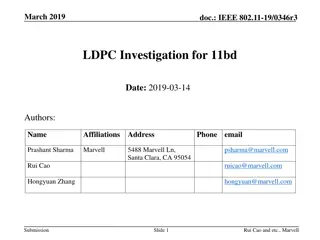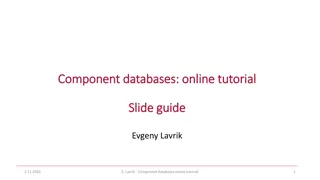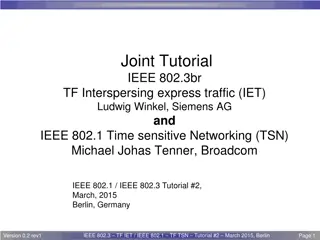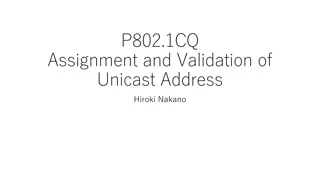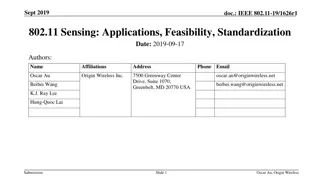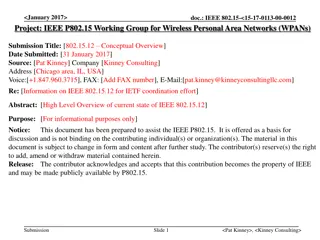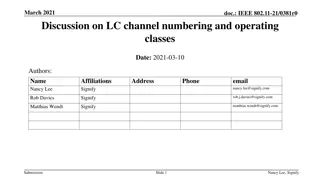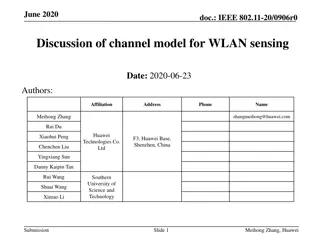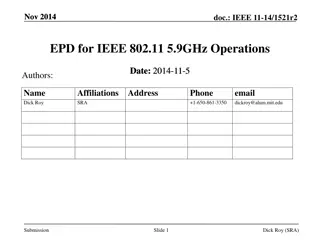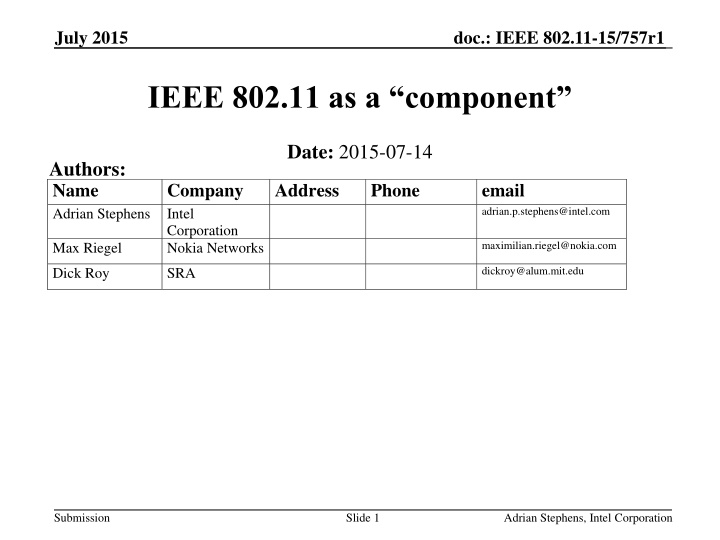
Managing 802.11 in Converged Networks: Future Work Discussion
Explore a presentation discussing the management of 802.11 in converged network architectures, highlighting challenges and opportunities for future standardization efforts in the context of 5G networks.
Download Presentation

Please find below an Image/Link to download the presentation.
The content on the website is provided AS IS for your information and personal use only. It may not be sold, licensed, or shared on other websites without obtaining consent from the author. If you encounter any issues during the download, it is possible that the publisher has removed the file from their server.
You are allowed to download the files provided on this website for personal or commercial use, subject to the condition that they are used lawfully. All files are the property of their respective owners.
The content on the website is provided AS IS for your information and personal use only. It may not be sold, licensed, or shared on other websites without obtaining consent from the author.
E N D
Presentation Transcript
July 2015 doc.: IEEE 802.11-15/757r1 IEEE 802.11 as a component Date: 2015-07-14 Authors: Name Adrian Stephens Intel Company Address Phone email adrian.p.stephens@intel.com Corporation Nokia Networks maximilian.riegel@nokia.com Max Riegel dickroy@alum.mit.edu Dick Roy SRA Submission Slide 1 Adrian Stephens, Intel Corporation
July 2015 doc.: IEEE 802.11-15/757r1 Introduction This submission is prepared for presentation at a tutorial session of IEEE 802. The goal is to stimulate discussion on a possible topic of future work in 802.11. That topic is how a 802.11 STA can be managed by non-proprietary interfaces inside a converged network architecture. Submission Slide 2 Adrian Stephens, Intel Corporation
July 2015 doc.: IEEE 802.11-15/757r1 Agenda 802.11 as a component Adrian Stephens (20 minutes) The problem statement The current status of 802.11 Intelligent Transport Systems (ITS) as an example of how 802.11 is implemented as a component of a defined system architecture (15 minutes) Dick Roy Omniran (IEEE P802.1CF) and its relevance to this topic Max Riegel (20 minutes) Discussion (40 minutes) - Adrian Q & A 20 minutes Opinion statement 20 minutes Wrap and Next Steps (10 minutes) Submission Slide 3 Adrian Stephens, Intel Corporation
July 2015 doc.: IEEE 802.11-15/757r1 The problem/opportunity statement Imagine a future 5G (or later!) network where all access to data from your mobile device passes through an operator core network This is one possible future vision. Not everybody agrees with this view. We have failed to provide 3GPP with a standardized means to meaningfully manage and control 802.11 networks. Perhaps, as a result, 3GPP have created their own 5GHz technology. The view of 5G described by NGMN includes usage models that naturally map onto projects in development in 802.11: TGay (60GHz), TGax (High efficiency 1-6 GHz), TGah (900 MHz). We should want to avoid any impediment for the use of appropriate 802.11 technology in a future 5G network. Submission Slide 4 Adrian Stephens, Intel Corporation
July 2015 doc.: IEEE 802.11-15/757r1 What is a component? For the purpose of this submission, a component has a defined function and defined external interfaces. The component doesn t care how it is used, provided that the use of the component matches the constraints of its defined external interfaces. It should be possible to swap implementations of the component from different sources provided those implementations are compliant to the defined functions and external interfaces. Submission Slide 5 Adrian Stephens, Intel Corporation
July 2015 doc.: IEEE 802.11-15/757r1 Is 802.11 a component now? Answer: No We have these main impediments: No concrete definition of our management interface, defined by various SAP primitives A theoretical MIB of which there is no compliant implementation. Lack of clarity as to whether the SME is part of the STA or not. There are shall statements for it, but no adequate interface to control it. Submission Slide 6 Adrian Stephens, Intel Corporation
July 2015 doc.: IEEE 802.11-15/757r1 State of the 802.11 MIB There are no compliant implementations of the 802.11 MIB. Our MIB is too big (200 pages) and badly structured SNMP has fallen out of favour as a means of network control The 802.11 MIB s main value is to define local variables used in normative text. It also defines metrics or control parameters accessed by proprietary interfaces. Contributors to the MIB through 802.11 amendments frequently lack experience, and drafts have to be coerced into updating the MIB through the MDR process Submission Slide 7 Adrian Stephens, Intel Corporation
July 2015 doc.: IEEE 802.11-15/757r1 Value of an abstract management API An abstract API allows an architectural partition to be specified, in terms of entities, interfaces between entities, and the behaviour of those entities This partition is not necessarily at the same level of granularity that would be chosen for a practical management API Because this choice of granularity is left to the implementer, a higher layer network management entity cannot depend on any uniform behaviour to manage. Submission Slide 8 Adrian Stephens, Intel Corporation
July 2015 doc.: IEEE 802.11-15/757r1 How does the industry cope now? The Station Management Entity has its own defined interfaces into the STA. These might match some of the abstract interfaces, but many do not. It is not possible to construct any workable device by bolting together off the shelf components. Instead, the construction of a working device from an 802.11 MAC is more akin to hand-cutting bolts to assemble a fire-arm in the era before Mr Whitworth. Submission Slide 9 Adrian Stephens, Intel Corporation
July 2015 doc.: IEEE 802.11-15/757r1 A practical measure of success? When 3GPP, or whoever defines 5G comes to us and says can you change your interface to do this , we want to be able to reply of course . Submission Slide 10 Adrian Stephens, Intel Corporation
July 2015 doc.: IEEE 802.11-15/757r1 Intelligent Transport System (ITS) as an example of how 802.11 is implemented as a component of a defined system architecture Dick Roy Submission Slide 11 Adrian Stephens, Intel Corporation
July 2015 doc.: IEEE 802.11-15/757r1 What should you take away? ITS communications involves massive deployments of 802 technologies/products (think IoE) including 802.11 as a component . The 5G (aka CALM) paradigm in ITS communications has been and continues to be standardized globally. Prototypes with 802.11 components have been built and successfully tested and they WORK! Products with 802.11 components are now on the market. Standardized 802.11 management and data plane interfaces would be beneficial! Submission Slide 12 Adrian Stephens, Intel Corporation
July 2015 doc.: IEEE 802.11-15/757r1 What is ITS? Intelligent Transport Systems (ITS): the application of advanced information and communications technology to surface transportation in order to achieve enhanced safety and mobility while reducing the environmental impact of transportation. [cf. http://www.its.dot.gov/standards_strategic_plan/#sthash.6p82feaS.dpuf] Cooperative ITS: a subset of overall ITS that communicates and shares information between ITS stations to give advice or facilitate actions with the objective of improving safety, sustainability, efficiency and comfort beyond the scope of stand-alone systems. [cf. Joint CEN and ETSI Response to Mandate M/453 dated 15 April 2010] Submission Slide 13 Adrian Stephens, Intel Corporation
July 2015 doc.: IEEE 802.11-15/757r1 Why should you care? SAFETY 33,561 highway deaths in 2012 5,615,000 crashes in 2012 Leading cause of death for ages 4, and 11-27 MOBILITY 5.5 billion hours of travel delay annually $121 billion cost of urban congestion annually ENVIRONMENT 2.9 billion gallons of wasted fuel annually 56 billion lbs of additional CO2 annually COST Accidents cost the US taxpayer approximately $300 billion annually! Submission Slide 14 Adrian Stephens, Intel Corporation
July 2015 doc.: IEEE 802.11-15/757r1 ITS Architecture ( High-level ) [http://www.its.dot.gov/arch/arch_longdesc.htm] Submission Slide 15 Adrian Stephens, Intel Corporation
July 2015 doc.: IEEE 802.11-15/757r1 ITS Communications Architecture Submission Slide 16 Adrian Stephens, Intel Corporation
July 2015 doc.: IEEE 802.11-15/757r1 Connected Vehicle Reference Implementation Architecture (CVRIA) The US DoT sponsored CVRIA project (a SafetyPilot follow-on ) objectives are to develop a Connected Vehicle Environment that is: a robust (resilient, secure, and operational) transportation (communication) environment where vehicles, mobile devices, and fixed infrastructure communicate agnostic to communications media selected based on function and cost improving traveler safety and traveler & goods mobility while minimizing environmental impacts Submission Slide 17 Adrian Stephens, Intel Corporation
July 2015 doc.: IEEE 802.11-15/757r1 Cooperative Vehicle-Infrastructure Systems (CVIS) The European CVIS project objectives were: to create a unified technical solution allowing all vehicles and infrastructure elements to communicate with each other in a continuous and transparent way using a variety of media and with enhanced localization; to enable a wide range of potential cooperative services to run on an open application framework in the vehicle and roadside equipment; to define and validate an open architecture and system concept for a number of cooperative system applications, [http://cvt-project.ir/En/EnNewsDetail.aspx?SubjectType=99&InfoID=1057] Submission Slide 18 Adrian Stephens, Intel Corporation
July 2015 doc.: IEEE 802.11-15/757r1 Cooperative Vehicle-Infrastructure Systems (CVIS) Some results from the European CVIS project: a multi-channel terminal capable of maintaining a continuous Internet connection over a wide range of carriers, including cellular, mobile Wi-Fi networks, infra-red or short-range microwave channels, ensuring full interoperability in the communication between different makes of vehicle and of traffic management systems; an open architecture connecting in-vehicle and traffic management systems and telematics services at the roadside, that can be easily updated and scaled up to allow implementation for various client and back-end server technologies; techniques for enhanced vehicle positioning and the creation of local dynamic maps, using satellite positioning, radio triangulation and the latest methods for location referencing; [http://cvt-project.ir/En/EnNewsDetail.aspx?SubjectType=99&InfoID=1057] Submission Slide 19 Adrian Stephens, Intel Corporation
July 2015 doc.: IEEE 802.11-15/757r1 Silo Approach to ITS Service Implementation (in Vehicles) Active Safety system VM Proprietary System EETS system eCall system Radio box (3G/LTE, WiFi, Bluetooth, GPS, ) Radio box (2G/3G, GPS, 5.8GHz, ) Radio box (2G/3G, GPS, ) Radio box (GPS, 5.9GHz, ) Ineffective, inefficient, and too expensive! Submission Slide 20 Adrian Stephens, Intel Corporation
July 2015 doc.: IEEE 802.11-15/757r1 CALM (5G) Approach to ITS Service Implementation (in Vehicles) Hard Safety System eCall Parking EETS Comm System (3G, LTE, WiFi, 5.9GHz, Bluetooth, GPS, ) VM Infotainment Firewall Proprietary ITS-S Host Vehicle HMI The 5G paradigm effective, efficient, and future proof! Submission Slide 21 Adrian Stephens, Intel Corporation
July 2015 doc.: IEEE 802.11-15/757r1 ITS station (ITS-S) Architecture Applications Traffic efficiency Road safety Other applications API API Communications MA SA MS MS management FA Application Facilities Authentication, authorization, profile management (Identity, crypto-key and certificate managment) Security Management Information Base (SMIB) Application support Information support MF MF SF SF Firewall and Intrusion management Session / communication support Management Information Base (MIB) management NF Station Management Security NF Networking & Transport Transport protocols SN MN MN SN ... management Cross-layer Networking protocols IN IN Access management Station-external interfaces Station-internal interfaces Regulatory MI MI SI SI Hardware Security Module (HSM) e.g. IR, 60 GHz, 5 GHz, 2G/3G, WiFi, 802.15.x, Ethernet [ISO 21217] Submission Slide 22 Adrian Stephens, Intel Corporation
July 2015 doc.: IEEE 802.11-15/757r1 ITS-S Architecture and Standards SAP SAP Null-networking and transport protocols | IPv6 Networking and transport protocols ISO 29281-1 / IEEE 1609.3,.4 | ISO 21210 SAP ITS-S Manager ISO 24102 SAP SAP SAP SAP SAP SAP SAP SAP SAP SAP ISO 21218 ISO 21218 ISO 21218 ISO 21218 ISO 21218 ISO 21218 ISO 21218 ISO 21218 ISO 21218 ISO 21218 ISO 21214 IR Manager ISO 21216 Millimeter Manager ISO 24xxx Broadcast Manager ISO 24xxx PAN Manager ISO 24xxx Wired Manager ISO 21212 ISO 21213 ISO 24103 ISO 21215 W-LAN Manager ISO 29283 W-MAN Manager SAP 2G Cell Manager 3G Cell Manager DSRC ISO15628 K-DSRC C-DSRC HC-SDMA RADAR WiMAX J-DSRC cdma2k W-USB MM-E UMTS EDGE AMIC MM-J GPRS BlueT Ether IR-A CAN IR-B DAB WiFi GPS M5 TC204 Media External Media ISO 21218 = LSAP Implements Virtual CIs! Data SAP Management SAP SAP SAP Submission Adrian Stephens, Intel Corporation Slide 23
July 2015 doc.: IEEE 802.11-15/757r1 ITS station (ITS-S) Path Selection Applications API ITS-S Facility Layer Protocols MF-SAP Communication profile selection ITS-S application requirements and objectives Path selection Communication protocols status ITS-S N&T Layer Protocols MN-SAP Set of rules (regulations, policies) ITS-S Access Layer Protocols MI-SAP ITS-S Management Communications [ISO 21217, ISO 17429, ISO 24102-x] Submission Slide 24 Adrian Stephens, Intel Corporation
July 2015 doc.: IEEE 802.11-15/757r1 ITS-S Subsystems Central ITS Station Personal ITS Station Central Host Central Gateway Border Router Applications Applications Management Management Facilities Facilities Security Security M anagement Facilities M anagement Networking & Transport Networking & Transport N etworking & Security Security ... ... ... Transport Access Access Access Technologies Ethernet Technologies Ethernet Technologies Ethernet CAN bus Networking & Transport IPv 6 ... Traffic Centre/Service Centre Access Technologies 3 Communication Networks Vehicle ITS Station Roadside ITS Station 5.9 Vehicle Gateway Vehicle Host Mobile Router Access Router Roadside Host Border Router Roadside Gateway Applications Applications M a n a g e m e n t Ma n a g e m e n t Facilities Facilities S e c u ri t y S e c u ri t y M a n a g em ent Ma na ge m e nt Facilities Facilities S e c u r it y M a n a g e m e nt S ec urity N etworking N etworking N etworking & Se curit y M a n a ge m en t Managem ent ... ... ... Transport Transport Transport & & N etworking N etworking & Transport N etworking N etworking & Security ECU S ec urity ... ... & Transport ... Transport ... & Transport ECU Access Access Access Technologies Technologies Technologies Access Access Access Access Technologies Technologies 5.9GHz Technologies Ethernet Technologies Ethernet Ethernet Ethernet CAN bus IPv 6 SENS Ctrl Loop Detector [ISO 21217] Submission Slide 25 Adrian Stephens, Intel Corporation
July 2015 doc.: IEEE 802.11-15/757r1 Why use 802.11(.15) CIs in ITS communications? 5.9 GHz OFDM PHY and CSMA/CA MAC OCB (TGp) Designed specifically for V2X safety applications in FCC allocated spectrum (similar in Europe) Low-cost, high-performance Wi-Fi (ISM bands) Value-added services, infotainment Non-safety related ITS services (e.g. probe data collection) Device configuration management (updates, security credentials, ) 60 GHz MAC/PHY High bandwidth suitable for video distribution (e.g platooning applications) Bluetooth Low-cost sensor networks (e.g. traffic sensors) [ISO 19079 (6LoWPAN), ISO 19080 (COAP)] Submission Slide 26 Adrian Stephens, Intel Corporation
July 2015 doc.: IEEE 802.11-15/757r1 Why do (multiple) CIs need to be managed ? RF issues Need to turn off 5.9 GHz CIs to take a 5.8 GHz toll! Intermodulation products can lead to self-jamming Prioritization of some CIs over others (e.g. safety-of-life CIs ) Calibration is necessary to ensure some level of performance Operational issues Congestion control/mitigation (load balancing) Handoff to maintain connectivity Virtual CIs to maximize usefulness of physical CIs Submission Slide 27 Adrian Stephens, Intel Corporation
July 2015 doc.: IEEE 802.11-15/757r1 ITS-S / WAVE Device Manufacturers (w/ one or more 802.11 CIs) AradaSystems Autotalks Cohda Wireless Commsignia Denso Essys Imtech ITRI Kapsch Lesswire Q-Free Ranix Savari Networks Submission Slide 28 Adrian Stephens, Intel Corporation
July 2015 doc.: IEEE 802.11-15/757r1 For More Information http://its-standards.info http://www.its.dot.gov http://www.iteris.com/cvria http://www.transport- research.info/web/projects/project_details.cfm?ID=382 60 Submission Slide 29 Adrian Stephens, Intel Corporation
July 2015 doc.: IEEE 802.11-15/757r1 Omniran (IEEE P802.1CF) and its relevance to this topic Max Riegel (IEEE 802.1 OmniRAN TG chair, Nokia Networks) Submission Slide 30 Adrian Stephens, Intel Corporation
doc.: IEEE 802.11-15/757r1 There is Evidence to consider Commonalities of IEEE 802 Access Networks More (huge) networks are coming up by everything gets connected e.g. SmartGrid, ITS, IoT, New markets for IEEE 802 access technologies e.g. factory automation, in-car communication, home automation, IEEE 802 access is becoming more heterogeneous multiple network interfaces e.g. IEEE 802.3, IEEE 802.11, IEEE 802.15 multiple access network topologies e.g. IEEE802.11 in residential, corporate and public multiple network subscriptions e.g. multiple subscriptions for same interface New emerging techniques, like SDN and virtualization Submission
doc.: IEEE 802.11-15/757r1 P802.1CF develops a functional description of a generic IEEE 802 access network External requirements from the service/deployment perspective Develop a logical/functional model for evaluation of those requirements; Available IEEE 802 specifications of protocols and attributes. ? A functional network specification based on an abstract network model supports evaluation and better understanding of existing IEEE 802 protocols for deployment in access networks. It illustrates commonalities among IEEE 802 access technologies while supporting specifics of individual technologies. The common model facilities deployment of IEEE 802 technologies. d02 Submission
doc.: IEEE 802.11-15/757r1 Access network views The physical view of an access network Subscription Service Information Server Terminal Access Network Backhaul Access Router Protocol layer architecture of an access network Application Application Transport Transport Network Network Network Data Link Physical Network Data Link Physical Data Link Data Link DL Phy DL Phy DL Phy DL Phy DL Phy DL Phy Physical Physical Medium Medium Medium Backhaul Medium Access Router Interface Medium Terminal Interface Node of Attachment Scope of P802.1CF STA AP Submission
doc.: IEEE 802.11-15/757r1 P802.1CF Network Reference Model Coordination and Information Service Subscription Service R11 R2 R10 R4 TE Ctrl AN Ctrl AR Ctrl R9 R8 R5 R7 Access Router Interface Terminal Interface NA Backhaul R1 R3 R6 Access Network Access Router Terminal STA AP NA = Node of Attachment {AP, BS} Submission
doc.: IEEE 802.11-15/757r1 P802.1CF Draft ToC Introduction and Scope Abbreviations, Acronyms, Definitions, and Conventions References Identifiers Network Reference Model Overview Reference Points Access Network Control Architecture Multiple deployment scenarios including backhaul Functional Design and Decomposition Dynamic Spectrum Access Network Discovery and Selection Association and Disassociation Authentication and Trust Establishment Datapath establishment, relocation and teardown Authorization, QoS and policy control Accounting and monitoring SDN Abstraction Annex: Privacy Engineering Tenets (Informative) Submission
July 2015 doc.: IEEE 802.11-15/757r1 P802.1CF provides an abstract network model for IEEE 802 Application view Guides deployment of IEEE 802 technologies Components Defines abstract functional entities of IEEE 802 technologies E.g. Node of Attachment, Backhaul, TE/AR Interface Generic Emphasizes commonalities among IEEE 802 technologies E.g. MAC Service, EAPoL, LMI Software oriented Creates data models for IEEE 802 access network and components. In OO terms: Definition of classes for access network , na , backhaul Extensible Provides basic/generic data structures for extension by technology specifics Submission Slide 36 Adrian Stephens, Intel Corporation
July 2015 doc.: IEEE 802.11-15/757r1 802.1CF facilitates Privacy engineered access network When the data in the access network is well defined, sensible parts of it can be protected. Software Defined Networking SDN gets an abstract model of a whole access network Access network virtualization It is easy to create multiple instances from a class definition Derivation of adapted network models for other kind of user plane transport E.g. Cable/DSL or NA directly attached to access router Submission Slide 37 Adrian Stephens, Intel Corporation
July 2015 doc.: IEEE 802.11-15/757r1 What 802.1CF can do for IEEE 802.11 as a component Describing IEEE 802.11 as a component would require 1) Deployment models 2) A control architecture, i.e. definition of entities exchanging control information with the component 3) An outline for the specification of the functional behavior from an application perspective 4) Restructuring the IEEE 802.11 control attributes from an application perspective 802.1CF would provide the solution for 1), 2), 3) Reinventing the wheel may lead to something quite similar to 802.1CF It would be left to 802.11 to develop an appropriate format of its LMI (Layer Management Information (MIB)) Submission Slide 38 Adrian Stephens, Intel Corporation
July 2015 doc.: IEEE 802.11-15/757r1 A practical measure of success? When 3GPP, or whoever defines 5G comes to us and says can you change your interface to do this , we want to be able to reply of course, we can show you, how you can adopt our technology to your system . Submission Slide 39 Adrian Stephens, Intel Corporation
July 2015 doc.: IEEE 802.11-15/757r1 Thank you for your attention. Any questions for clarification on P802.1CF? Submission Slide 40 Adrian Stephens, Intel Corporation
July 2015 doc.: IEEE 802.11-15/757r1 Key Discussion Points Is this really an IEEE 802 / 802.11 standards issue? Relevance of IEEE P802.1CF Relevance of IEEE 802.21 Relevance of ISO/CEN/ETSI standards Who are the customers for this interface? Are we trying to manage the AP or the non-AP STA? How do we sustain the ability of implementers to differentiate? What is the level of granularity of control? Submission Slide 41 Adrian Stephens, Intel Corporation
July 2015 doc.: IEEE 802.11-15/757r1 Notes from floor discussion Will we lose the value of 802.11 by reducing it to the lowest common denominator? Take example of 802.3, needed to acquire technical expertise from both 802.11 and external experts in the interface technology Questions whether outcome is linked to standard Consider also IETF as a standards provider for interfaces Need to consider Management, Control and Data interfaces. We don t have a view of the whole system. What are we trying to manage: QoS? Provide 802.11-specific examples of what will be controlled that cannot be controlled today? What is the desired outcome of the exercise? We should be providing control/management of 802 as a whole. Whole issue is too abstract. What organizations should we be talking to to understand requirements? How do we become specific? Lack of specification of management can be viewed as increased flexibility. Submission Slide 42 Adrian Stephens, Intel Corporation
July 2015 doc.: IEEE 802.11-15/757r1 Straw Poll 1 Do you believe there need to be additional standardized interfaces for the control and management of IEEE 802.11? Yes 36 No 2 Abstain 19 Submission Slide 43 Adrian Stephens, Intel Corporation
July 2015 doc.: IEEE 802.11-15/757r1 Straw Poll 2 Should IEEE 802.11 work on additional standardized interfaces for management and control of IEEE 802.11? Yes 28 No 5 Abstain 24 14 willing to work. Submission Slide 44 Adrian Stephens, Intel Corporation





